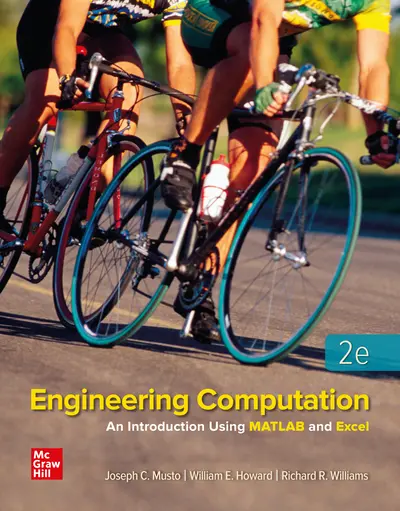My Account Details

ISBN10: 007338027X | ISBN13: 9780073380278

Engineering Computation: An Introduction Using MATLAB and Excel
Product not yet available for student view. Change to an older release to view student options.
- Lowest Price!
McGraw Hill eBook
Textbook Rental (150 Days Access)
- Rent for a fraction of the printed textbook price
- Complete text bound in hardcover or softcover
Loose-Leaf Purchase
Unbound loose-leaf version of full text
Shipping Options
- Standard
- Next-day air
- 2nd-day air
Orders within the United States are shipped via FedEx or UPS Ground. For shipments to locations outside of the U.S., only standard shipping is available. All shipping options assume the product is available and that processing an order takes 24 to 48 hours prior to shipping.
Note: Connect can only be used if assigned by your instructor.
Connect (180 Days Access)
- Digital access to a comprehensive online learning platform
- Includes homework, study tools, eBook, and adaptive assignments
- Download the free ReadAnywhere app to access the eBook offline
McGraw Hill eBook
Details:
- Normally the lowest price option for student
- Integrates in your LMS
- Accessible tools for students, including read-aloud functionality, jump links and dynamic note-taking and highlighting features
Textbook Rental (150 Days Access)
Details:
- Rentable option
- Hardcopy and softcover formats
Loose-Leaf Purchase
Details:
- Unbound loose-leaf version of full text
Connect (180 Days Access)
Details:
- Integrates in your LMS
- Prebuilt courses, presentation slides and instructor resources
- Test question banks, adaptive assignments, essay prompts, video content and more interactive exercises specific to your course subject
- eBook access (with included ReadAnywhere app)
- Print book add-on availability
- Remote proctoring
* The estimated amount of time this product will be on the market is based on a number of factors, including faculty input to instructional design and the prior revision cycle and updates to academic research-which typically results in a revision cycle ranging from every two to four years for this product. Pricing subject to change at any time.
This text provides a detailed introduction to the computational techniques, numerical methods, and computational tools used by engineering students. It is aimed at first or second year students, and is intended to provide the theoretical and computational foundation required for advanced study in engineering. The text provides a foundation in computational theory, and an overview of thenumerical methods used by engineering students and practicing engineers. The text focuses on implementation of these computational techniques using two widely-used software packages: MATLAB, which provides a structured programming environment, and Excel, which is a ubiquitous spreadsheet application. Throughout the text, these two softwares are used to demonstrate the computational techniques developed in the text, and their advantages and limitations are described.
PART 1
Chapter 1: Computing Tools
Chapter 2: Excel Fundamentals
Chapter 3: MATLAB Fundamentals
Chapter 4: MATLAB Programming
Chapter 5: Plotting Data
PART 2
Chapter 6: Finding the Roots of Equations
Chapter 7: Matrix Mathematics
Chapter 8: Solving Simultaneous Equations
Chapter 9: Numerical Integration
Chapter 10: Optimization
About the Author
Joseph Musto
Joseph Musto holds a B.S. from Clarkson University, and an M.Eng. and Ph.D. from Rensselaer Polytechnic Institute, all in mechanical engineering. Before beginning his academic career, Dr. Musto worked in industry in held industrial positions with Brady Corporation (Milwaukee, WI) and Eastman Kodak Company (Rochester, NY). He is a registered professional engineer in the state of Wisconsin. He has been using and teaching solid modeling using SOLIDWORKS since 1998.
William Howard
William "Ed" Howard holds a B.S. in civil engineering and an M.S. in engineering mechanics from Virginia Tech, and a Ph.D. in mechanical engineering from Marquette University. He is an associate professor in the East Carolina University Department of Engineering, where he teaches solid modeling, engineering computations, solid mechanics, and composite materials. Before beginning his academic career, Dr. Howard worked in industry for 14 years in design, analysis, and project engineering at Thiokol Corporation (Brigham City, UT), Spaulding Composites Company (Smyrna, TN), and Sta-Rite Industries (Delavan, WI). He is a registered professional engineer in the state of Wisconsin.
Richard Williams
Need support? We're here to help - Get real-world support and resources every step of the way.